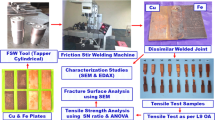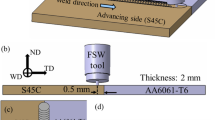Abstract
The welding process parameters of dissimilar 2024-T4 and 7075-T6 aluminum alloy friction stir welded (FSWy) joints are selected by the metallographic microstructure, the mechanical properties, and the hardness distribution. The joints with rotational speed of 900 rpm and advancing speed of 100 mm/min that have the highest tensile strength are used to carry out the experimental fatigue research. The short crack growth behavior of dissimilar FSW joints is analyzed through the replica technique. The stage of the crack initiation and stable growth accounts for about 60~80% of total fatigue life. The short crack grows rapidly once it reaches the crack size of approximately 350~450 μm. The cracks are prone to initiate at the defects of subsurface in the weld nugget zone and propagate in a quasi-cleavage fracture mode.










Similar content being viewed by others
Abbreviations
- Q :
-
Heat input per unit length
- α :
-
Heat input efficiency
- q :
-
Heat input
- v :
-
Traverse speed
- μ :
-
Friction coefficient
- P :
-
Pressure
- R :
-
Shoulder radius
- ω :
-
Rotation speed
- ΔN :
-
Increment of cycle numbers
- Δa :
-
Increment of crack length
- N i :
-
Cycle numbers
- N f :
-
Cycle numbers of total fatigue life
- a :
-
Surface crack length
- a i :
-
Surface crack length at Ni cycles
- ΔK :
-
Stress intensity factor range
- area :
-
Projected area of the crack
- σ max :
-
Maximum stress
- σ min :
-
Minimum stress
- Δσ :
-
Stress range
References
Mastanaiah P, Sharma A, Reddy GM (2016) Dissimilar friction stir welds in AA2219-AA5083 aluminium alloys: effect of process parameters on material inter-mixing, defect formation, and mechanical properties. T Indian I Metals 69(7):1397–1415
Mishra RS, Ma ZY (2005) Friction stir welding and processing. Mater Sci Eng R 50(1–2):1–78
Tarasov SY, Rubtsov VE, Fortuna SV, Eliseev AA, Chumaevsky AV, Kalashnikova TA, Kolubaev EA Ultrasonic-assisted aging in friction stir welding on Al-Cu-Li-Mg aluminum alloy. Weld World 61(4):679–690
Venkateswaran P, Reynolds AP (2012) Factors affecting the properties of friction stir welds between aluminum and magnesium alloys. Mater Sci Eng A 545:26–37
Shokri V, Sadeghi A, Sadeghi MH (2017) Effect of friction stir welding parameters on microstructure and mechanical properties of DSS–Cu joints. Mater Sci Eng A 693:111–120
Aval HJ (2015) Microstructure and residual stress distributions in friction stir welding of dissimilar aluminium alloys. Mater Design 87:405–413
da Silva AAM, Arruti E, Janeiro G, Aldanondo E, Alvarez P, Echeverria A (2011) Material flow and mechanical behaviour of dissimilar AA2024-T3 and AA7075-T6 aluminium alloys friction stir welds. Mater Design 32:2021–2027
Khodir SA, Shibayanagi T (2008) Friction stir welding of dissimilar AA2024 and AA7075 aluminum alloys. Mater Sci Eng B 148(1–3):82–87
Cavaliere P, Panella F (2008) Effect of tool position on the fatigue properties of dissimilar 2024-7075 sheets joined by friction stir welding. J Mater Process Technol 206(1–3):249–255
Cavaliere P, De Santis A, Panella F, Squillace A (2009) Effect of welding parameters on mechanical and microstructural properties of dissimilar AA6082-AA2024 joints produced by friction stir welding. Mater Design 30(3):609–616
Miller KJ (1987) The behaviour of short fatigue cracks and their initiation. 2. A general summary. Fatigue Fract Eng Mater Struct 10(2):93–113
Besel Y, Besel M, Mercado UA, Kakiuchi T, Hirata T, Uematsu Y (2017) Influence of local fatigue damage evolution on crack initiation behavior in a friction stir welded Al-Mg-Sc alloy. Int J Fatigue 99:151–162
Deng CY, Gao R, Gong BM, Yin TH, Liu Y (2017) Correlation between micro-mechanical property and very high cycle fatigue (VHCF) crack initiation in friction stir welds of 7050 aluminum alloy. Int J Fatigue 104:283–292
Rodriguez RI, Jordon JB, Allison PG, Rushing T, Garcia L (2016) Low-cycle fatigue of dissimilar friction stir welded aluminum alloys. Mater Sci Eng A 654:236–248
Jordon JB, Bernard JD, Newman JC (2012) Quantifying microstructurally small fatigue crack growth in an aluminum alloy using a silicon-rubber replica method. Int J Fatigue 36(1):206–210
Brochu M, Verreman Y, Ajersch F, Bouchard D (2012) Propagation of short fatigue cracks in permanent and semi-solid mold 357 aluminum alloy. Int J Fatigue 36(1):120–129
Kim YG, Fujii H, Tsumura T, Komazaki T, Nakata K (2006) Three defect types in friction stir welding of aluminum die casting alloy. Mater Sci Eng A 415(1–2):250–254
Trimble D, O’Donnell GE, Monaghan J (2015) Characterization of tool shape and rotational speed for increased speed during friction stir welding of AA2024-T3. J Manuf Process 17:141–150
Oskouei RH, Ibrahim RN (2011) The effect of a heat treatment on improving the fatigue properties of aluminium alloy 7075-T6 coated with TiN by PVD. Procedia Engineering 10:1936–1942
Prudhomme M, Billy F, Alexis J (2018) Effect of actual and accelerated ageing on microstructure evolution and mechanical properties of a 2024-T351 aluminium alloy. Int J Fatigue 107:60–71
Yan L, Fan JK (2016) In-situ SEM study of fatigue crack initiation and propagation behavior in 2524 aluminum alloy. Mater Design 110:592–601
Alexandre F, Deyber S, Pineau A (2004) Modeling the optimum grain size on the low cycle fatigue life of a Ni based superalloy in the presence of two possible crack initiation sites. Scr Mater 50:25–30
Tan JT, Chen BK (2013) Coalescence and growth of two coplanar short cracks in AA7050-T7451 aluminium alloys. Eng Fract Mech 102:324–333
Guan J, Wang LQ, Zhang CW, Ma XX (2017) Effects of non-metallic inclusions on the crack propagation in bearing steel. Tribol Int 106:123–131
Murakami Y, Endo M (1986) Effects of hardness and crack geometry ofΔKthof small cracks. J Soc Mater Sci Jpn 35(395):911–917
Funding
This work is financially supported by the National Natural Science Foundation of China (Grant Nos. 11672010, 51535001, 51575012).
Author information
Authors and Affiliations
Corresponding author
Additional information
Publisher’s note
Springer Nature remains neutral with regard to jurisdictional claims in published maps and institutional affiliations.
Recommended for publication by Commission XIII - Fatigue of Welded Components and Structures
Rights and permissions
About this article
Cite this article
Sun, GQ., Xu, GS., Shang, DG. et al. Welding parameter selection and short fatigue crack growth of dissimilar aluminum alloy friction stir welded joint. Weld World 63, 1761–1769 (2019). https://doi.org/10.1007/s40194-019-00773-6
Received:
Accepted:
Published:
Issue Date:
DOI: https://doi.org/10.1007/s40194-019-00773-6




